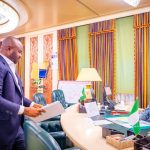ANTHONY KILA
Anthony Kila is a Jean Monnet professor of Strategy and Development. He is currently Institute Director at the Commonwealth Institute of Advanced and Professional Studies, CIAPS, Lagos, Nigeria. He is a regular commentator on the BBC and he works with various organisations on International Development projects across Europe, Africa and the USA. He tweets @anthonykila, and can be reached at anthonykila@ciaps.org
In 2019, Sri Lanka experienced a severe economic crisis characterised by a shortage of foreign exchange reserves. This resulted in defaults on external debt and significant economic hardship. The crisis, which peaked between 2022 and 2023, arguably represents the worst post-independence crisis in the country. Sri Lanka gained independence in 1948, and conditions had never been so dire until 2022.
Though never described as a wealthy country, before the 2022 economic crisis, Sri Lanka was widely viewed as a progressive lower-middle-income nation in South Asia, exhibiting encouraging signs of post-conflict development and tourism-driven growth. The conclusion of its three-decade-long civil war in 2009 initiated a period of relative peace, infrastructure development, and economic optimism, although challenges persisted.
Many Sri Lankans, particularly in urban centres, enjoyed access to free education and healthcare, improved infrastructure, and rising digital connectivity. Middle-class lifestyles were growing, with consumer goods, electronics, and imported vehicles becoming more common. It must be noted here that the rural areas lagged in all these, and income inequality persisted.
Tourism was a significant source of income and employment for many Sri Lankans, attracting millions of visitors annually for its beaches, heritage sites, and wildlife. This sector created hospitality, transport, and retail jobs, bringing foreign currency into the economy.
For many residents of Sri Lanka, the country was a place that offered access to consumer goods, stable electricity, fuel supplies, and a growing retail sector before 2022. The presence of thriving international brands and a booming construction industry reflected consumer confidence and growth trends. However, this vibrancy also came with increasing household debt and rising living costs.
Agriculture, apparel exports, tourism, and remittances from overseas workers primarily drove Sri Lanka’s economy. The country’s urban areas experienced rapid development due to investments in highways, ports, and real estate. However, the economy remained vulnerable to external shocks and heavily depended on foreign loans and imports. Debt servicing was high, yet everyday life for many was relatively stable, with access to fuel, food, and medicine. Time Magazine
highlighted the consequences of abrupt agricultural policy changes when the crisis blew up:
“Sri Lanka’s political and economic crisis… is deeply tied to the nation’s failed attempt to transition to organic farming”.
The country’s relative stability was disrupted in 2019 by a sharp shortage of foreign exchange, resulting in shortages of essential goods and fuel. This was mainly due to a decline in tourism, remittances, and the devastating COVID-19 pandemic. Other factors, such as domestic policy errors, significant tax cuts, excessive monetary financing, and a fixed exchange rate, also compounded the situation.
Thanks to the economic situation, life became a daily struggle as Sri Lankans had to deal with acute shortages of essential goods, including fuel, cooking gas, medicines, and food. Long queues formed outside petrol stations and pharmacies, sometimes lasting for days. Inflation skyrocketed, with food prices rising more than 90 percent by mid-2022, making basic meals unaffordable for many.
Fuel shortages led to frequent power outages, some lasting up to 13 hours per day. Schools, factories, and businesses were forced to shut down or operate under limited conditions. The electricity and water supply became unreliable, deeply affecting public life and productivity. Hospitals ran out of essential drugs and equipment, while surgeries and treatments were postponed. In August 2022, Human Rights Watch reported:
“Sri Lanka’s economic crisis is driving millions of people into poverty, jeopardising their rights to health, education, and an adequate standard of living.”
Reversing years of progress and development in the country’s trajectory, unemployment rose sharply due to the collapse of tourism, agriculture, and small businesses. Many Sri Lankans lost their jobs or saw their incomes diminish. The World Bank reported that over 500,000 people fell below the poverty line.
The growing hardship triggered mass protests nationwide, generating movements like the “Aragalaya” (Struggle) movement in 2022. Citizens from all walks of life demanded political reform, accountability, and relief from hardship. The widespread unrest eventually led to President Gotabaya Rajapaksa’s resignation in July 2022.
The government struggled to meet basic expenditures and binding commitments, resulting in defaults on its external debts. Sri Lanka’s external debt surpassed $50 billion, with major creditors including China, India, Japan, and international capital markets. In May 2022, The Guardian noted:
“Sri Lanka defaulted on its debt for the first time since independence, indicating a worsening economic crisis.”
In just over three years, from 2019 to 2022, the economic crisis in Sri Lanka transformed a once-promising lower-middle-income country into a nation in humanitarian distress, forcing millions to change their daily lives drastically. It exposed deep structural weaknesses and sparked a national reckoning concerning governance, sustainability, and resilience.
In 2025, it might be hyperbolic to say the crisis is over, but it is safe to say the worst is over, as the country is now in recovery and has moved from a distress zone to one that continues to journey to stability and growth.
Sri Lanka’s path out of the devastating economic crisis of 2019–2022 involved a combination of international assistance, internal policy reforms, and gradual stabilisation efforts.
In March 2023, Sri Lanka finalised a $3 billion Extended Fund Facility (EFF) with the International Monetary Fund (IMF). This deal provided immediate financial relief and helped restore some investor and public confidence. The IMF programme offered financial support, a policy roadmap, and credibility in negotiations with other creditors. The conditions attached to their intervention included fiscal consolidation (raising taxes, reducing deficits, restructuring public debt, strengthening the Central Bank’s independence, and implementing anti-corruption measures).
Sri Lanka began negotiations with bilateral and commercial creditors, including China, India, Japan, and international bondholders, to restructure over $40 billion in debt. The delayed repayments gave the country fiscal space to stabilise the economy. This temporary suspension of foreign debt payments in 2022 was crucial in avoiding collapse. Talks focused on debt sustainability, more extended grace periods, and reduced interest rates.
For its part, the government took several internal measures to institute policies and institutional reforms to regain economic control. Some significant reforms include reversing the 2019 tax cuts and increasing VAT and income tax rates to boost state revenue. The Central Bank was granted more independence, and it implemented inflation-targeting policies. The Sri Lankan rupee was allowed to float, reducing pressure on the Central Bank and helping restore balance in foreign exchange markets. The government is taking drastic steps to reduce the sizes and costs of state-owned enterprises.
Once the currency stabilised, importing essential items became more manageable in the country. Sri Lanka is now bolstering its once depleted foreign reserves through IMF funding and increased remittances.
Join me @anthonykila, if you can, to continue these conversations.









